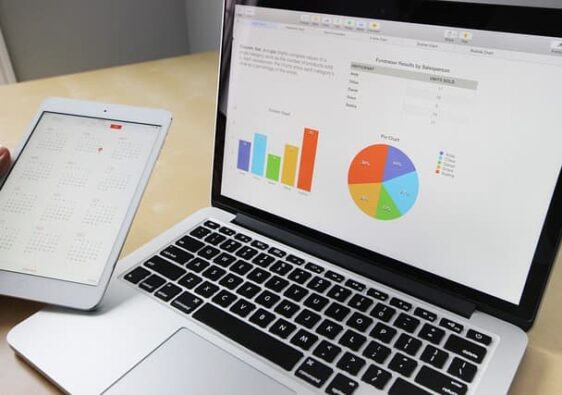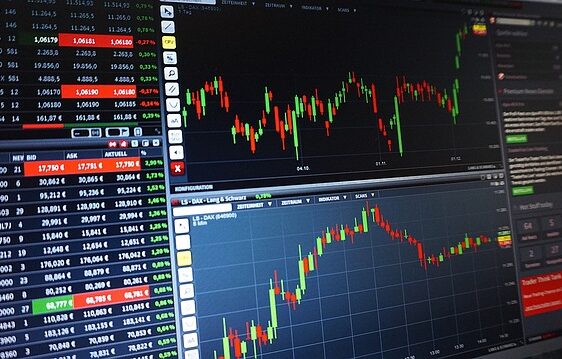Traders use technical indicators to gain additional insight into future price movements of an asset. Such tools facilitate the identification of various patterns and provide buy or sell signals under certain market conditions. There are many indicators that are used in day trading, swing trading and sometimes even in long-term investments. While some professional market players even create their own indicators. In this article we will briefly describe some of the most popular technical analysis indicators that can be useful additions to any trader’s tool kit.
Relative Strength Index (RSI)
The Relative Strength Index (RSI) is an impulse indicator, which provides indications on the basis of which one can conclude whether an asset is overbought or oversold. It does so by measuring the magnitude of recent price movements (the standard setup consists of 14 periods, 14 days, 14 hours, etc.). The data is then displayed as an oscillator, which can have a value between 0 and 100.
Since the RSI is an impulse indicator, it represents the force with which price changes. This means that if the indicator is increasing when the price is rising, the upward trend is strong and more and more buyers are coming. On the contrary, if the indicator measure decreases and the price increases, it may indicate that the sellers may soon gain control of this market.
The traditional interpretation of RSI is in the numerical reading of the line on the chart: if it is above 70, then the asset is overbought, and when it is below 30, then the asset is considered oversold. Thus, extreme values may indicate an impending trend reversal or pullback. However, it would be better not to consider these values as direct buy or sell signals. As with many other technical analysis (TA) methods, RSI can produce false or misleading signals, so it’s always a good idea to consider other factors before entering a trade.
Moving Average (MA)
The Moving Average (MA) smoothes out price fluctuations, filtering out market noise and highlighting the direction of the trend. Because the MA is based on past price data, it is a lagging indicator.
The two most commonly used moving averages are the simple moving average (SMA or MA) and the exponential moving average (EMA). The SMA is formed on the basis of price data for a certain period, and their average value. For example, a 10-day SMA is constructed by calculating the average price of the past 10 days. The EMA, on the other hand, gives more weight to the most recent price data. This makes it more sensitive to recent price changes.
As mentioned above, the moving average is a lagging indicator. The longer the period, the longer the signal lag. Thus, a 200-day SMA is much slower to react to a recent price change than a 50-day SMA.
Traders often use ratios of price to specific moving averages to gauge the current trend. For example, if price stays above the 200-day SMA for an extended period, then most traders consider such a market to be bullish.
Traders can also use crossovers or so-called crossovers of moving averages as a signal to buy or sell. For example, if the 100-day SMA crosses over the 200-day SMA, this might be considered a sell signal. But what exactly does this cross mean? It indicates that the average price of the last 100 days is now lower than the last 200 days. The selling idea here is that short-term price movements no longer follow the uptrend and in most cases the trend could change.
Moving Average Convergence/Divergence (MACD)
MACD (short for Moving Average Convergence Divergence) is a technical indicator, designed to determine the future price movement of an asset by means of interconnecting two moving averages. It consists of two lines: the MACD line and the signal line. The MACD line is calculated by subtracting the 26-day EMA from the 12-day EMA and plots the result against the 9-day EMA, which serves as the signal line. Many charting tools often include a histogram that shows the distance between these lines.
By looking for a divergence (divergence) between the MACD and the price movement, traders can get an idea of the strength of the current trend. For example: the price shows a new maximum, while the MACD shows a very low reading, which indicates that the market could soon reverse. Because of this indicator, we can conclude: that with such a high price and low momentum there is a high probability for a pullback or reversal.
In addition, traders can use this indicator to look for crosses between the MACD line and its signal line. As a rule, a signal to buy is considered when the MACD line crosses the signal line from bottom to top. And vice versa, a point where the MACD signal line crosses the signal line downward is considered a sell signal.
The MACD is often used in conjunction with the RSI because both indicators measure momentum, but do so from different data. It is suggested that together they can give a more complete technical view of the market.
Stochastic RSI (StochRSI)
Stochastic RSI (Relative Strength Index) is an oscillator, which tracks the price movements to determine if an asset is overbought or oversold. As the name implies, the stochastic is a derivative of the regular RSI, which is formed on the basis of basic indicators instead of price data. The indicator is calculated by applying the stochastic RSI formula to regular RSI values. The standard settings of the indicator range from 0 to 1 (or 0 to 100).
Due to its sensitivity, the stochastic RSI can generate many difficult to interpret trading signals. As a rule, it tends to be most useful when indicators are near the upper or lower extremes of its range.
If the RSI stochastic is above 0.8 it is considered overbought and a value below 0.2 may indicate over-sold. A value of 0 means that RSI has the lowest value in the measured period (the default setting is usually 14). Alternatively, a value of 1 means that RSI has the highest value during the measurement period.
Similar to the standard indicator settings, stochastic RSI overbought or oversold signals do not mean that price will go in the exact direction the indicator is pointing. In this case, it simply indicates that the RSI values (from which the stochastics RSI values were derived) are close to the extremes. It is important to remember that stochastic RSI is more sensitive than its predecessor, so it generates more false or misleading signals.
Bollinger Lines (BB)
Bollinger Lines measure the volatility of the market and also determine overbought and oversold levels of an asset. The indicator consists of three lines: SMA (middle band), upper and lower bands. The settings can vary, but basically the upper and lower lines are two standard deviations from the moving average. The distance between the lines is directly related to volatility, the distance changes when it increases or decreases.
As a rule, the closer the price is to the upper line, the more overbought the chosen asset is. In the opposite situation, the closer the price is to the bottom line, the higher it is oversold. In most cases the price does not go beyond the lines, but it is possible that it may break above or below them. While this scenario may not be a trading signal in itself, it serves as an indicator of extreme market conditions.
Another most important concept from the lines is called squeeze (from the English squeeze). This case refers to the period of low volatility, when all the lines are very close to each other. In this situation, the indicator can signal the potential volatility in the future, in the opposite case, if the lines are at a great distance from each other, it can indicate a possible decrease in price fluctuations.
Conclusion
Although technical indicators provide data to help you navigate the market, it’s important to keep in mind that the interpretation of such data is highly subjective. Therefore, before you form your trades you need to take care that your personal biases do not influence your decision-making in any way. What might be a direct buy or sell signal for one trader will look like mere market noise to another.
As with most market analysis methods, indicators are most effective when used in conjunction with each other or with other methods, such as Fundamental Analysis (FA).
The best way to learn technical analysis (TA) is through plenty of practice.



